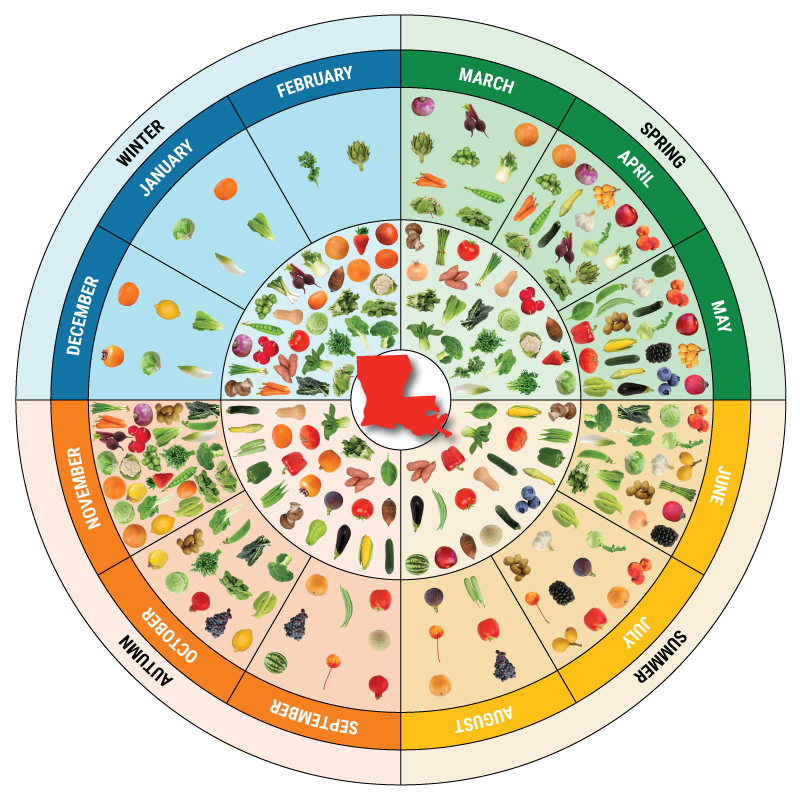Farm to School in the Cafeteria Manual - Local Food Procurement

Louisiana Cycle Menu Seasonality Wheel
Local Food Procurement
There are many methods for getting local food into your cafeteria. Regardless of the method you choose, you must always follow federal procurement rules and regulations. The resources below will help navigate the procurement process.
USDA Local Food Procurement Regulations and Policies
Procurement Methods: Informal vs. Formal Decision Making Process
Finding, Buying, and Serving Local Foods Webinar Series (USDA 2014)
Procuring Local Foods for Child Nutrition Programs (USDA Guide)
Local Procurement Basics
10 Facts About Procuring Local Food for Schools: This fact sheet from USDA Farm to School outlines facts for getting local food into schools.
Using Geographic Preference
How to Use Geographic Preference: This fact sheet from the USDA explains what geographic preference is and how to use it.
Final Rule on Geographic Preference: This is a memo from Food and Nutrition Services including Q & A about geographic preference.
Sourcing Local Foods
You can source local foods for your Farm to School program all year with a little planning, knowing what products are in season and by working with your distributors and local farmers.
Channels for Sourcing Local
Distributors
Direct from Farmer
School Gardens
Farmers Markets
Buyers Cooperatives
Food Hubs
Tips for Sourcing Seasonal Food
-
Buy fresh fruits and vegetables that are in season.
Late Summer: sweet potatoes, green peas/snap peas, cucumbers, eggplant, mushrooms, okra, peppers, squash, tomatoes, watermelon
Fall: greens, sweet potatoes, green peas/snap peas, spinach, cabbage, cucumber, eggplant, mushrooms
Winter: broccoli, chards, greens, spinach, carrots, citrus, sweet potatoes, winter squash, cabbage, mushrooms, radishes
Spring: broccoli, chards, greens, lettuce, spinach, carrots, sweet potatoes, green peas/shell peas, cauliflower, mushrooms, radishes, strawberries, summer squash, tomatoes, blueberries
Summer: lettuce, sweet potatoes, cantaloupe, green peas, snap/snow peas, potatoes, cucumbers, eggplants, mushrooms, onions, peppers, tomatoes, watermelon -
Buy from farmers who use season extension methods such as high tunnels or greenhouses.
Example: Richland Parish School Board renovated greenhouses at Rayville High School to grow hydroponic lettuce and tomatoes for their school cafeteria meals (late winter or early spring: salad greens). -
Buy protein, dairy products, and non-perishable food items year-round.
Protein and Dairy: Seafood, meat and dairy products such as milk are typically available in Louisiana year-round.
Non-perishable Items: Whole grains and rice are easy to store with no loss of quality for year-round availability.
Local Food Procurement Success Stories/In the News
- 2016
-
Richland Parish School Board
A Fresh Approach to Feeding Students (article)
Finding Local Food
There are several ways to find local products. Below are great databases, tools and resource organizations that will support your efforts.
Louisiana Market Maker: This is a searchable database of growers and producers in the state.
Louisiana Department of Agriculture and Forestry: Your state Department of Agriculture is a great resource for identifying local farmers.
Louisiana Grown. Real. Fresh.: This website was developed by the Louisiana Department of Agriculture and includes contact information for specialty crop farmers and producers in Louisiana.
Cooperative Extension: Connecting with cooperative extension is a great way to learn what farmers and producers are in your area. In Louisiana, Louisiana State University and Southern University both have Agriculture Research Centers with cooperative extension agents who can help you locate local farmers.
USDA Farm to School Census: This census provides information on what schools and districts in Louisiana are participating in Farm to School. Use this tool to see who in your area is purchasing local food.
The Farmers Market Directory: The Farmers Market Directory is an online directory with information about Farmers Market locations, directions, operating times, product offerings, accepted forms of payment, and more. Connecting with your nearby Farmers Market is a great way to build a relationship with local farmers.
Louisiana Farm to School: Louisiana’s statewide Farm to School network can help you connect with local farmers and others who are sourcing locally.
Seasonality Wheel
Click on a month or season in the Cycle Menu Seasonality Wheel to see what Louisiana products are available or select a product in the legend to see when it is available.
Resources
USDA Food Buying Guide
USDA Local Procurement Resources: This Fact Sheet from USDA outlines webinars, resources and FNS memos about Farm to School.
Produce Calculator: This tool developed by Oklahoma Farm to School is based off the USDA Food Buying Guide for Child Nutrition Programs. The spreadsheet calculates per serving cost based on the price of the product and calculates poundage needed based on the desired number of servings and serving size.
How to Use a Request for Information: This page contains the basics on how to gather information about local farmers and product using a Request For Information or "RFI".
Forward Contract Sample: This document is a sample template for a school.
Louisiana Grown Fruit and Vegetable Seasonality Chart: This chart is color coded for food service by vegetable colors and organized by season.




